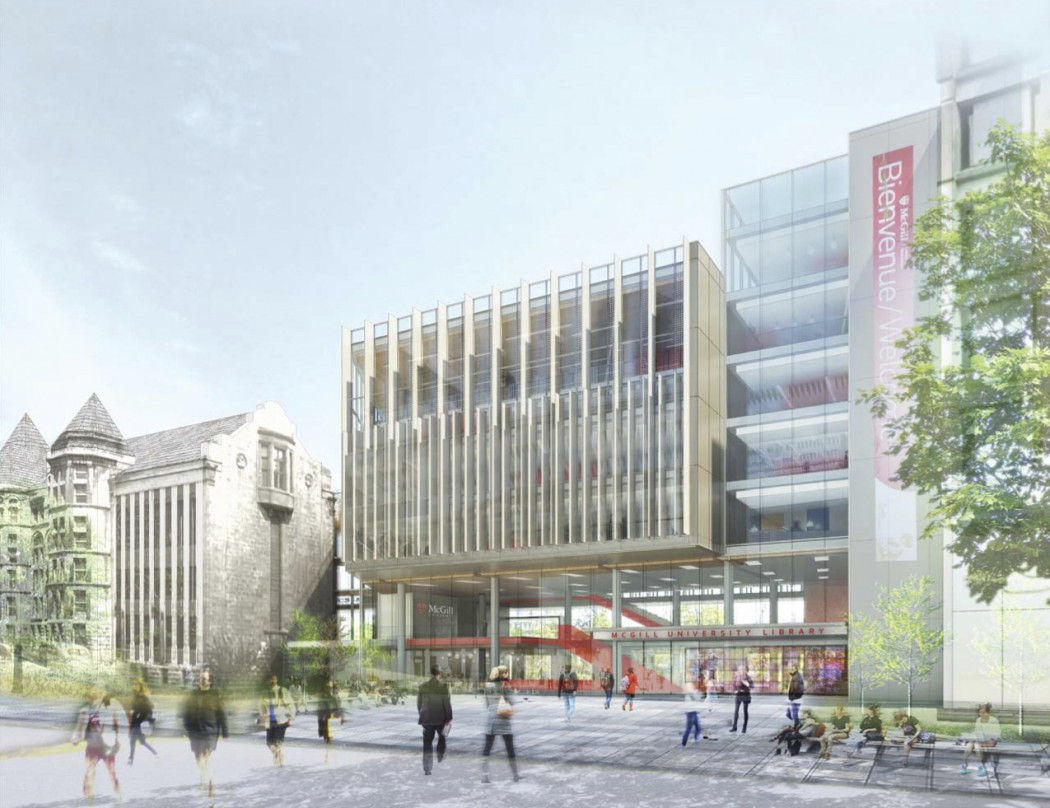“IN THE QUIET & STILL AIR OF DELIGHTFUL STUDIES,” reads the wall just next to the steps of Redpath. It’s a lovely Milton quote, but isn’t currently applicable to most students’ experience at McGill’s largest library.
The entrance to the McLennan-Redpath library is inaccessible, counter-intuitive, and often crowded. Although renovations have been made recently, such as the expansion of the cafeteria and terrace, problems remain; workspace, for example, is highly coveted inside the library. “Come final exam time, people don’t have a place to study,” said Sam Pousht-Massad, Faculty of Law.
With its dim lighting and tight spaces, the library is no longer an ideal location for the fostering of academic development at McGill. As McGill’s library administration explains in their Master Plan document, the book collection and student body have simply grown beyond capacity in recent years to allow for adequate room in the McLennan-Redpath building.
Proposed Changes
McGill’s library administration and the Friends of the Library Committee have been planning a large-scale renovation of McLennan-Redpath since 2013 due to the facility’s current inability to meet the needs of its users. In 2014, McGill formed a project team composed of library administration and representatives from the architectural firms Shepley Bulfinch and EKM. Additionally, a steering and communications committee were formed to advise the project team and ensure that a diverse range of library users could give feedback throughout the planning process.
The project team has proposed a five-year construction plan set up in three phases. During the first phase, an Automated Storage and Retrieval System (ASRS) will be built below Lower Field, along with some small renovations within the library to better connect the buildings and prepare for the next two phases of construction. The ASRS, which is described by the project team as an “underground robotic storage facility,” will move and store a large part of the library’s collection, which will free up library space and services for its users. Many universities, such as the University of British Columbia, California State University, and the University of Chicago, already make use of this technology in their libraries.
Once the ASRS is constructed, the books in McLennan-Redpath will be moved so that library renovations can begin, and an atrium will be added to the Redpath Library Building in order to highlight its “outstanding heritage value”. Its reconstruction will involve the addition of two storeys, enormous bird-friendly windows (thanks to a pattern on the glass that will allow for birds to distinguish the panes from open air) with natural light, and an expansion of the building towards McTavish street in order to better align Redpath and McLennan. A “linear hub” will also be added between the Redpath and McLennan buildings, which will expand the McLennan building and provide an opportunity to address maintenance issues that have so far been neglected.
Sustainability Efforts Across Campus, Thanks to Renovations
Of the issues that will be addressed during the proposed renovations, one of the most important is the energy consumption issue across the campus’ libraries. McIntyre’s Life Sciences Library is also undergoing corrective renovations for heating, ventilation, and air conditioning (HVAC) as part of the larger “Reimagining the McGill University Library and Archives” project.
The third phase of construction on the McLennan building involves HVAC replacement in the Rare Books & Special Collections section, which currently constitutes 23% of Redpath-McLennan’s annual energy costs due to its aging and inefficient climate control system. Redpath Hall will also be updating its HVAC, significantly cutting energy consumption costs for the library in conjunction with growing sustainability initiatives across campus.
Logistics: Funding, Timelines, and Ongoing Planning
Over the expected five years of construction, the estimated cost is 165 million; 65 million during the two-year first phase, 80 million over the next two years of construction in the Redpath building, and 20 million in the project’s final year. In their FAQ, the project team stated their intention of looking for funding in “all avenues”: federal and provincial funding, loans and partnerships, and donations from philanthropic organizations and/or the McGill community at large.
Construction dates cannot be set until this funding is at least partially acquired, which means that there is no specific construction timeline currently in place. However, the feasibility study has clarified the need for the library to remain open throughout all phases of construction. The project team is currently working on a business plan “to create a sound financial foundation on which to build”.
Other immediate and emerging priorities are currently being explored: these include renovating washrooms in McLennan-Redpath and Schulich, developing policies regarding food and noise level, and updating digital services and databases to better suit current demands.
Student Response
As the biggest group of library users, student voices are extremely important to the overall planning initiative. Opinions regarding the project generally reflect excitement for the proposed changes, but the uncertain timeline and possibility of compromised study space has caused anxiety for some.
“If it’s gonna take 5-8 years, how will [the planning committee] make sure people aren’t miserable during the construction?” Pousht-Massad asked, seeming skeptical. Noise level during construction, as he quickly pointed out, could affect a number of undergraduates studying at McGill. The possible benefits outweighed the risks, however:
Concordia has an entrepreneurship incubator, it’s absolutely beautiful…It’d be nice to have space for entrepreneurs to come and explore ideas, […] to build something together, because right now we don’t have anything like that. If other campuses can make these improvements, why can’t we?
Anastasya Voloshyn, a U3 psychology major, also voiced a desire for more social spaces in the library. “I’m always in the [Cyberthèque], and I don’t like it when it’s too silent,” she admitted, smiling. “I would like to have more spaces like the Cyber. Less isolated, where you can talk a little and walk around”.
Natural lighting is also an appealing factor for students. “I think the plans themselves are beautiful, there’s a lot more natural light. I’m just hoping they’ll clean the windows a little more often than they do now,” joked James Paolino, a Hispanic Studies major.
Keeping “humanities books in the humanities library” was also important to Paolino, and other students felt the same way about retaining easy access to the collection: “I don’t use a lot of older books, that’s more Humanities than Sciences, but I wouldn’t like it if they were completely removed. Every time I search for a book, it’s always here,” Voloshyn offered. Storing the books with another university was actually an alternative proposed during the visionary process. Marina Simonian, Management Faculty, seemed unsurprised that this proposal had been rejected. “It has to be well-defined,” she said.
When asked if the proposed changes would increase her library usage, Voloshyn grinned. “I already use it [to the] maximum,” she laughed. But, she said being in the library would be more enjoyable. Pousht-Massad echoed this sentiment: “I have to use the library regardless, but I would be happier in my use of it. It would definitely improve my mental state”.
“I’m graduating, but I suppose the natural light will make it a lot more pleasant for students who come here,” Paolino answered. Many of the students interviewed felt, like Paolino, that natural light and a pleasant environment to study would improve student life. Regardless of the uncertainty of the new library, the proposed renovations for McLennan-Redpath seem to inspire the hope in students that their studies – or those of students coming after them – may be delightful once more.


